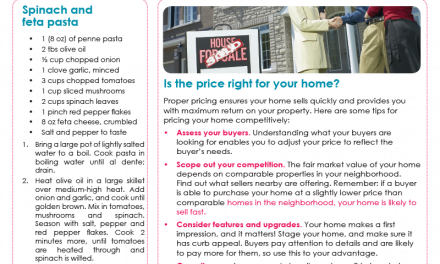Energy efficiency: what’s the big deal?
Being green isn’t just about being trendy. Going green means saving on long-term property operating expenses. It also translates to a lower chance of default. Homeowners with energy efficiency improvements are up to 33% less likely to default on their mortgage, according to a study by the University of North Carolina.
More importantly, nine out of ten homebuyers say they prefer to purchase a home with built-in energy efficient improvements, even if the purchase price is two-to-three percent higher than a home lacking these improvements. The prospect of a comparatively low utility bill makes spending more on the purchase attractive for prudent homebuyers.
Related article:
National Association of Home Builders: NAHB Study Reveals What Home Buyers Really Want
So what constitutes “going green”? Going green means using building materials, appliances or methods which are:
- environmentally friendly;
- responsibly and/or locally sourced;
- recycled; or
- renewable.
Unless they’re wealthy or extremely conscientious, most homebuyers are interested in how green improvements can save them money. Watch your labels, here: “green” doesn’t always mean long-term savings. Some green improvements are driven primarily by social intentions, and can end up costing quite a lot. To reap the financial benefits of going green, green improvements need to be energy efficient. Energy efficiency aims to reduce the amount of energy used by the homebuyer, thereby reducing their energy costs.
Therefore, it’s important for you to be able to differentiate between a purely “green” improvement and a truly energy-efficient one. Once that’s done, make it your goal to know the ins-and-outs of energy-efficient improvements: how to make them, and how much they will cost (and save) your homebuyer clients.
Energy efficiency: all the options
First, start with an energy audit, also known as a Home Energy Rating System (HERS) audit. Your homebuyer or your seller can order an energy audit of the property to pinpoint energy-efficient improvements, or features in need of energy-efficient improvements. HERS auditors also give homes a score based on the home’s energy saving abilities.
For homebuyers contemplating the purchase of an energy-inefficient home, the audit provides ammunition for negotiating a purchase price in line with the improvement costs, or long-term operating costs.
For sellers who have made energy-efficient improvements, the HERS audit provides an official way to toot their energy-efficient horns and justify higher listing prices. [See first tuesday Form 150, §11.h]
Related article:
The six most common energy-efficient improvements are:
- efficient lighting;
- sealing around doors and windows;
- proper insulation;
- energy efficient appliances;
- whole house fans; and
- solar panels.
1. Lighting
The easiest and cheapest way a homeowner can save money is by trashing energy-sucking light bulbs and upgrading to light emitting diode (LED) light bulbs. LED light bulbs last up to 25 times longer than incandescent bulbs, and consume 3-30% the amount of energy regular bulbs consume. They also don’t give off heat like other bulbs do, helping reduce air conditioning costs.
Lighting costs can also be reduced by installing dimmers in place of traditional light switches (although not all LED bulbs work with dimmers – make sure your homeowner checks). A homeowner can do a self-install for the cost of the dimmer ($20-$50).
Related article:
2. Sealing
Properly sealing the home’s building envelope (doors, windows, foundation, roof and walls) can dramatically reduce the costs of cooling and heating the home. Sealing materials include caulk, weather-stripping and expandable spray-foam.
The areas around doors and windows are the most obvious spots to check for sufficient sealing. An energy audit can discover the not-so-obvious spots. The auditor will perform a blower door test to discover any leaks. The homeowner can do seal leaks themselves for the cost of the sealing materials, or have a professional do it.
The cost to seal a home ranges from $300 for a do-it-yourself project to $2,000 for a professional job. The savings average 20% of the annual heating and cooling costs along with 10% of the home’s total energy costs, according to the Environmental Protection Agency (EPA).
3. Insulation
Adding more insulation will, in most cases, reduce the energy bill. An energy audit will also identify where more insulation needs to be added.
A quick way for your homeowner to find out whether they have insulation in a particular area is to turn off the power and unscrew an electrical outlet. They’ll be able to see clearly whether or not there is insulation present (though a flashlight might help).
4. Appliances
An obvious, but slightly more costly energy fix is to replace old appliances with new, energy-efficient appliances. These come branded with the EnergyStar label of approval. Appliances to consider upgrading include:
- refrigerator / freezers;
- washer / dryers ;
- air conditioners;
- water heaters;
- computers;
- televisions; and
- dishwashers.
The EPA determines the qualifications required for appliances to earn the EnergyStar label. If the appliance costs more than a similar energy-inefficient appliance, the owner will recover the additional cost through the energy savings accrued by the EnergyStar appliance (within a reasonable time period).
5. Whole house fans
Whole house fans are on their way to becoming as commonplace as microwaves in California homes. Chances are you’re already familiar with this product.
The fan (usually installed in an attic) pulls cool air from outside through the home at night, pre-cooling the home for the hotter daytime hours. This augments the homeowner’s air conditioning system, reducing cooling costs on average 50%-90% a year.
The cost to purchase and install a whole house fan varies from $300-$1,500. The investment will usually begin paying off in one-and-a-half to two years.
Related article:
6. Solar panels
Solar energy is very quickly making its mark on California’s landscape. However, the cost of solar panels can be prohibitive for individual homeowners. The average cost to purchasing and install solar panels on a California residence is $34,800. That amounts to 15-20 years of use before the investment begins to pay off.
Large commercial businesses are more likely to have the cash to install solar improvements. Lancaster, California recently became the first city in the world to vow to produce more energy (harnessed with solar panels) than it uses each day. The city is expected to save over $7 million in energy costs over the next 15 years.
Lancaster partnered with SolarCity, which offers homeowners (as well as businesses and governments) the ability to lease solar panels for zero-money down. This option allows homeowners to benefit from solar energy without actually making the investment. The homeowner then pays SolarCity a reduced, set rate for electricity for the length of the contract, which is typically 20 years.
Another option for homeowners who wish to directly own their solar panels is to find a government-sponsored rebate or financing program. See GoSolar’s website for additional information.
Related articles:
Editor’s note — Solar leasing has its drawbacks. In fact, signing a solar lease can potentially derail a home sale down the line. To avoid these complications:
- ask the solar leasing company about the requirements for transferring a solar lease to a homebuyer before you sign a contract;
- do the math to figure out if the monthly savings are worth the potential complications with the eventual sale; and
- if you decide to go with a solar lease, disclose the solar lease to all potential homebuyers upfront to make sure it doesn’t become an issue before closing.
Strategies for making energy efficient improvements
When installing any home improvement, the homeowner needs to ask themselves: why are they doing this? In other words:
- Is this improvement going to increase their use and enjoyment of their residence now?; and/or
- Is the improvement going to increase the value of their home when they sell?
The vast majority of energy-efficient improvements will increase the home’s value, while also allowing the homeowner to save money over several years. However, there are some notable exceptions.
First, leasing solar panels can prove tricky when the homeowner decides to sell. SolarCity is eager to transfer their service over to the buyer of a home subject to their lease. But what if the homebuyer doesn’t want a solar lease? There are several options, but – as experience has taught many agents – solar leases can prove to be an obstacle when trying to close a deal.
Second, any energy-efficient improvement must be installed for a certain number of months or years before the investment will begin paying off. The inverse is also true: if an energy-saving improvement has been installed for too long, it becomes outdated and obsolete. It can actually lower the value of the home.
Thus, timing is significant.
Strategies when selling
If your seller client has made energy-efficient improvements (unless they fall under the exceptions listed just above) then you are in luck, because green homes are in high demand.
However, you have to let potential buyers know about the energy-saving improvements! Have your seller order a HERS energy audit, and advertise this on the listing, or provide it to prospective homebuyers at an open house.
If your seller doesn’t want to order a full HERS audit, be sure to draw up a cost-comparison sheet which lays the utility cost of your seller’s energy-efficient home with a similar energy-inefficient home down the block. Circle the monthly savings for the potential buyer, compare this with the monthly cost for the higher purchase price, and they will likely be willing to pay top dollar. [See first tuesday Form 150, §11.h]
Remember, homebuyers want the best home for the smallest cost. With energy-efficient improvements, they can get both.
Related article:
Energy mortgages: monthly savings take you from red to green


















